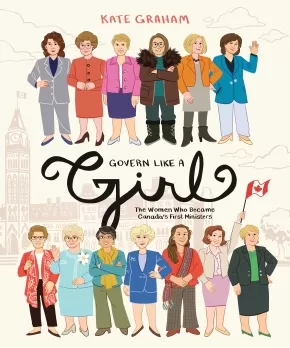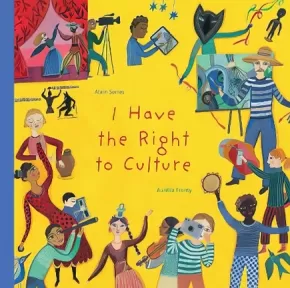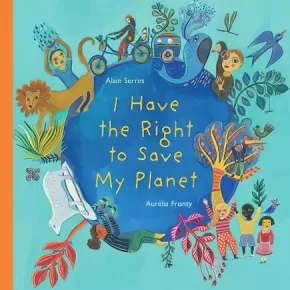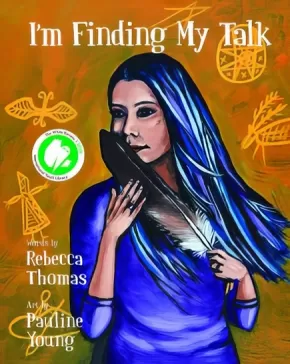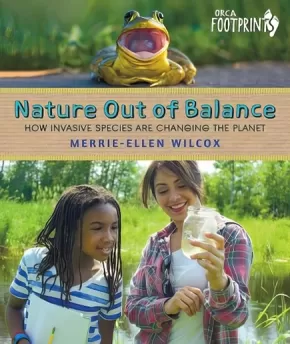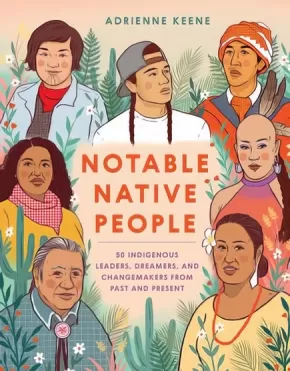
Information Circles
106
-
120
of
192 Results;
Sort By
Go To
of 13
Chasing Bats and Tracking Rats: Urban Ecology, Community Science, and How We Share Our Cities
$14.95
Artists:
Format:
Paperback
ISBN / Barcode: 9781773215396
Synopsis:
Synopsis:
Gripping narrative non-fiction with STEM and social justice themes that proves cities can be surprisingly wild places—and why understanding urban nature matters.
What can city bees tell us about climate change? How are we changing coyote behavior? And what the heck is a science bike? Featuring the work of a diverse group of eleven scientists—herself included!—Dr. Cylita Guy shows how studying urban wildlife can help us make cities around the world healthier for all of their inhabitants. In the process, Guy reveals how social injustices like racism can affect not only how scientists study city wildlife, but also where urban critters are likelier to thrive. Sidebars include intriguing animal facts and the often-wacky tools used by urban ecologists, from a ratmobile to a bug vacuum. Cornelia Li’s engaging illustrations bring the scientists’ fieldwork adventures to life, while urban ecology challenges encourage readers to look for signs of wildlife in their own neighborhoods.
Educator Information
Recommended for ages 9 to 12
Themes: biology, environmental science & ecosystems, experiments & projects
Table of Contents
Introduction: Living in the Urban Jungle
Talk Like an Urban Ecologist: Key Terms
Chapter 1: Chasing Down Big Browns
How much do wildlife rely on city green spaces? Cylita Guy tracks bats in Toronto, Canada.
Chapter 2: Ratmobile to the Rescue
How do animals in cities affect human health? Kaylee Byers studies how rats move around Vancouver, Canada.
Chapter 3: Bees and Bug Vacuum
Why are cities a good place to study the impact of climate change on bees? Charlotte de Keyzer looks at what bees and the plants they pollinate can tell us about the effects of climate change in cities like Toronto, Canada.
Chapter 4: Backyard Bear Buffet
What happens when humans and wildlife in cities don’t get along? Jesse Popp gets to the bottom of human-bear conflict in Sudbury, Canada.
Chapter 5: Bold Coyote, Bashful Coyote
How are humans changing animal behavior in cities? Chris Schell studies coyote behavior in Utah and Washington, and looks at how human policies like redlining affect urban biodiversity.
Chapter 6: Microplastics, Major Problems
How does the pollution we create affect city animals? Rachel Giles wades into Toronto’s waterways to discover the impacts of pollution on invertebrates.
Chapter 7: Birdwatching Bias
What happens when citizen science doesn’t tell us the whole story? Deja Perkins asks how human bias can affect what we know about birds in cities like Durham, Chapel Hill, and Raleigh, North Carolina.
Chapter 8: A Bike to Beat the Heat
Why are greener cities better for people? Carly Ziter pedals around Madison, Wisconsin to track how trees cool cities.
Conclusion: But this is only the beginning!
Acknowledgments
Select Sources
Index
Additional Information
104 pages | 7.50" x 9.80" | Paperback
Everything You Wanted to Know About Indians But Were Afraid to Ask: Young Readers Edition (HC) (4 in Stock)
$28.99
Format:
Hardcover
Text Content Territories:
Indigenous American; Native American;
ISBN / Barcode: 9781646140459
Synopsis:
Synopsis:
From the acclaimed Ojibwe author and professor Anton Treuer comes an essential book of questions and answers for Native and non-Native young readers alike. Ranging from "Why is there such a fuss about nonnative people wearing Indian costumes for Halloween?" to "Why is it called a 'traditional Indian fry bread taco'?" to "What's it like for natives who don't look native?" to "Why are Indians so often imagined rather than understood?", and beyond, Everything You Wanted to Know About Indians But Were Afraid to Ask (Young Readers Edition) does exactly what its title says for young readers, in a style consistently thoughtful, personal, and engaging.
Updated and expanded to include:
• Dozens of New Questions and New Sections—including a social activism section that explores the Dakota Access Pipeline, racism, identity, politics, and more!
• Over 50 new Photos
• Adapted text for broad appeal
Educator Information
Recommended for ages 9 to 12.
This book has a Native American/US focus.
Additional Information
400 pages | 1.11" x 1.11"
Finding Home: The Journey of Immigrants and Refugees
$24.95
Artists:
Format:
Hardcover
ISBN / Barcode: 9781459818996
Synopsis:
Synopsis:
What drives people to search for new homes?
From war zones to politics, there are many reasons why people have always searched for a place to call home. In Finding Home: The Journey of Immigrants and Refugees we discover how human migration has shaped our world. We explore its origins and the current issues facing immigrants and refugees today, and we hear the first-hand stories of people who have moved across the globe looking for safety, security and happiness. Author Jen Sookfong Lee shares her personal experience of growing up as the child of immigrants and gives a human face to the realities of being an immigrant or refugee today.
Educator & Series Information
Recommended for ages 9 to 12.
This book is part of the Orca Thinks series.
Additional Information
120 pages | 7.00" x 9.00" | Hardcover
Govern Like a Girl: The Women Who Became Canada's First Ministers
$22.95
Format:
Paperback
Text Content Territories:
Indigenous Canadian; Inuit; Inuvialuit (Mackenzie Inuit);
ISBN / Barcode: 9781772602104
Synopsis:
Synopsis:
What does it take to govern like a girl? A fascinating look at the trailblazing women who rose to the top as first ministers in Canada.
Only twelve women have ever served as the premier of a Canadian province or territory, and only one has risen to the very top to serve as prime minister. In Govern Like a Girl, Kate Graham tells the stories of these thirteen women, from childhood to political power. Their experiences span three decades, every political stripe, and extend from coast to coast to coast. What motivated them to run for office? What did they accomplish once they were elected? And how did their style of governing differ from male politicians?
From Indigenous premiers, Eva Aariak and Nellie Cournoyea, to Premier and later Senator Catherine Callbeck of Prince Edward Island, to Québec's first female premier, Pauline Marois, these powerful women changed Canada for the better and showed the world how to govern like a girl.
Educator Information
Recommended for ages 9 to 12.
Includes a glossary and a map of Canada.
Learn about:
Premier Eva Aariak, Nunavut
Premier Catherine Callbeck, Prince Edward Island, and later, Senator
Prime Minister Kim Campbell
Premier Christy Clark, British Columbia
Premier Caroline Cochrane, Northwest Territories
Premier Nellie Cournoyea, Northwest Territories
Premier Pat Duncan, Yukon, and later, Senator
Premier Kathy Dunderdale, Newfoundland and Labrador
Premier Rita Johnston, British Columbia
Premier Pauline Marois, Quebec
Premier Rachel Notley, Alberta
Premier Alison Redford, Alberta
Premier Kathleen Wynne, Ontario
Additional Information
112 pages | 7.50" x 9.00" | 13 b&w illustrations | Paperback
Growing Up Trans: In Our Own Words
$24.95
Editors:
Format:
Paperback
ISBN / Barcode: 9781459831377
Synopsis:
Synopsis:
What does it mean to be young and transgender today? Growing Up Trans shares stories, essays, art and poetry created by trans youth aged 11 to 18. In their own words, the works illustrate the trans experience through childhood, family and daily life, school, their bodies and mental health. Together the collection is a story of the challenges, big and small, of being a young trans person. At the same time, it’s a toolkit for all young people, transgender or not, about what understanding, acceptance and support for the trans community looks like. In addition to the contributed works, there are questions and tips from experts in the field of transgender studies to challenge the reader on how to be a trans ally.
Growing Up Trans came out of a series of workshops held in Victoria, British Columbia, to bring together trans youth from across the country with mentors in the community.
Educator Information
Recommended for ages 10+
Additional Information
176 pages | 6.00" x 8.50" | Paperback
I Have the Right to Culture
$19.99
Artists:
Format:
Hardcover
ISBN / Barcode: 9781773064901
Synopsis:
Synopsis:
From the author and illustrator duo who created the award-winning I Have the Right to Be a Child and I Have the Right to Save My Planet comes this beautifully illustrated third book in the series.
I Have the Right to Culture explores a child’s right to be curious and to experience all of humanity’s shared knowledge, including music, art, dance and much more. When a child is born, they learn the language of their parents, they sing the songs of their grandparents and they eat the delicious food that their family prepares. They also start to wonder about the lives of other children who live far away. What languages do they speak? What songs do they sing? And what games do they play?
Every child has the right to learn about the world they live in, including its history and its inventions. Every child has the right to learn about artists, about writers, about potters and photographers and architects, about musicians and dancers and poets. All of humanity’s treasures are for sharing, and every child has the right to know about what has come before them! Children have the right to partake in culture as proclaimed in the United Nations Convention on the Rights of the Child.
Told from the perspective of a child, this colorful and vibrant book explores what it means to be a child who has the right to find beauty in their world.
Educator & Series Information
Recommended for ages 3 to 6.
This book is part of the I Have the Right series.
Correlates to the Common Core State Standards in English Language Arts:
CCSS.ELA-LITERACY.RI.K.1
With prompting and support, ask and answer questions about key details in a text.
CCSS.ELA-LITERACY.RI.K.6
Name the author and illustrator of a text and define the role of each in presenting the ideas or information in a text.
CCSS.ELA-LITERACY.RI.K.7
With prompting and support, describe the relationship between illustrations and the text in which they appear (e.g., what person, place, thing, or idea in the text an illustration depicts).
CCSS.ELA-LITERACY.RI.1.8
Identify the reasons an author gives to support points in a text.
Additional Information
48 pages | 10.00" x 10.00" | Hardcover
I Have the Right to Save My Planet
$19.95
Artists:
Format:
Hardcover
ISBN / Barcode: 9781773064871
Synopsis:
Synopsis:
This beautifully illustrated picture book is about a child’s right to advocate for the environment they live in.
All children have the right to learn about the world, to celebrate the water, air and sunshine, and to be curious about the animals and plants that live on our planet. All children also have the right to learn about endangered species, to be concerned about plastic in the ocean, and to understand what a changing climate means for our Earth.
Scientists tell us that every living thing is connected. When we cut down forests, we destroy animal habitats. When we throw plastic in the garbage, it never really goes away. When we spray pesticides on our fruit and vegetables, we poison the earth, animals and ourselves.
What can children do to help? All children can draw posters of endangered animals to raise awareness. All children can send a letter to the leader of their country, signed by every member of their family. All children can protest along with their parents. Children have the right to do all these things as proclaimed in the United Nations Convention on the Rights of the Child. All children have the right to try to help our Earth, in whatever ways they can.
Told from the perspective of a child, this colorful and vibrant book explores what it means to be a child who dreams of a beautiful future for their planet.
Educator & Series Information
Recommended for ages 4 to 7.
Part of the I Have the Right series.
Correlates to the Common Core State Standards in English Language Arts:
CCSS.ELA-LITERACY.RI.2.3
Describe the connection between a series of historical events, scientific ideas or concepts, or steps in technical procedures in a text.
CCSS.ELA-LITERACY.RI.3.2
Determine the main idea of a text; recount the key details and explain how they support the main idea.
CCSS.ELA-LITERACY.RI.3.3
Describe the relationship between a series of historical events, scientific ideas or concepts, or steps in technical procedures in a text, using language that pertains to time, sequence, and cause/effect.
CCSS.ELA-LITERACY.RI.2.6
Identify the main purpose of a text, including what the author wants to answer, explain, or describe.
CCSS.ELA-LITERACY.RI.1.8
Identify the reasons an author gives to support points in a text.
CCSS.ELA-LITERACY.RI.2.8
Describe how reasons support specific points the author makes in a text.
Additional Information
48 pages | 10.00" x 10.00"
I Lost My Talk (PB)
$13.95
Artists:
Format:
Paperback
Text Content Territories:
Indigenous Canadian; First Nations; Mi'kmaq;
ISBN / Barcode: 9781774710050
Synopsis:
Synopsis:
I lost my talk
The talk you took away
When I was a little girl
At Shubenacadie school.
One of Rita Joe's most influential poems, "I Lost My Talk" tells the revered Mi'kmaw Elder's childhood story of losing her language while a resident of the residential school in Shubenacadie, Nova Scotia. An often quoted piece in this era of truth and reconciliation, Joe's powerful words explore and celebrate the survival of Mi'kmaw culture and language despite its attempted eradication.
A companion book to the simultaneously published I'm Finding My Talk by Rebecca Thomas, I Lost My Talk is a necessary reminder of a dark chapter in Canada's history, a powerful reading experience, and an effective teaching tool for young readers of all cultures and backgrounds. Includes a biography of Rita Joe and striking colour illustrations by Mi'kmaw artist Pauline Young.
Reviews
"This picture book version of I Lost My Talk is best read with Rebecca Thomas’s I’m Finding My Talk. These haunting, evocative books bring an original approach to the exploration of Canadian residential schools in picture books. For readers and teachers who appreciate fact-based information, there is also “A Short History of Residential Schools” at the end of I Lost My Talk. Educators, librarians, and families will find their classrooms and book collections invaluably enriched by these books. They are real tools of truth and reconciliation; as such, they belong on every bookshelf in Canada and beyond." - CM Reviews
Educator Information
Recommended for ages 4 to 9.
This work features a short history of residential schools and information about the author.
Recommended in the Canadian Indigenous Books for Schools 2020/2021 resource list for grades 1-7 for English Language Arts.
Additional Information
32 pages | 8.00" x 10.00"
I'm Finding My Talk (PB)
$13.95
Artists:
Format:
Paperback
Text Content Territories:
Indigenous Canadian; First Nations; Mi'kmaq;
ISBN / Barcode: 9781774710067
Synopsis:
Synopsis:
I'm finding my talk
And it may take some time,
But I'm learning to speak
In a language that's mine.
A response to Rita Joe's iconic poem "I Lost My Talk," and published simultaneously with the new children's book edition illustrated by Pauline Young, comes a companion picture book by award-winning spoken-word artist and Mi'kmaw activist Rebecca Thomas. A second-generation residential school survivor, Thomas writes this response poem openly and honestly, reflecting on the process of working through the destructive effects of colonialism.
From sewing regalia to dancing at powow to learning traditional language, I'm Finding My Talk is about rediscovering her community, and finding culture. Features stunning, vibrant illustrations by Mi'kmaw artist Pauline Young.
Reviews
"Published as a companion to the picture book I Lost My Talk, featuring the famous poem by Rita Joe, both volumes explore the legacy of Canada’s residential schools. They feature vibrant illustrations by Pauline Young that bring the words alive with emotional nuance. This remarkable pair of books possesses the rare ability of being suited to readers of all ages: three to six-year-olds, the traditional intended audience of picture books, will be captivated by the bright, lively illustrations; elementary and middle school children will find their Social Studies curriculum enriched by experiencing these important concepts rendered creatively; teens and adults will gain insight and empathy by enjoying these beautiful poems." - CM Reviews
"[A]n honest reflection on the process of working through the destructive effects of colonialism by participating in cultural connections. This book offers the opportunity to show the journey one takes when rediscovering their community and culture." - The Dalai Lama Center
Educator Information
Recommended for ages 4 to 9.
Recommended in the Canadian Indigenous Books for Schools 2020/2021 resource list for grades 1-3 in the areas of Social Studies and Language Arts.
Former Halifax Poet Laureate and second-generation residential school survivor Rebecca Thomas writes honestly and powerfully in this companion piece to Rita Joe's I Lost My Talk. Includes vibrant illustrations from Mi'kmaw artist Pauline Young.
Additional Information
32 pages | 8.00" x 10.00"
Inuit Wayfinding - Nunavummi Reading Series
$17.95
Format:
Paperback
Text Content Territories:
Indigenous Canadian; Inuit;
ISBN / Barcode: 9781774500828
Synopsis:
Synopsis:
Before maps, compasses, and GPS, Inuit used observation and experience to find their way in the Arctic.
This book describes some of the traditional methods Inuit traditionally used to navigate on the land and sea, including using the sun and stars and looking carefully at snowdrifts. Quotations from Elders preserve this knowledge for future generations.
Educator & Series Information
This book is part of the Nunavummi Reading Series, a Nunavut-developed series that supports literacy learning while teaching readers about the people, traditions, and environment of the Canadian Arctic. It is a Level 18 book in the series.
Curriculum Connections: Indigenous History, Traditional Knowledge about Navigation.
Recommended for ages 10-11.
Additional Information
30 pages | 8.00" x 10.00" | Colour Photographs | Paperback
Nature Out of Balance: How Invasive Species Are Changing the Planet
$19.95
Format:
Hardcover
ISBN / Barcode: 9781459823952
Synopsis:
Synopsis:
Plants, animals, insects and fish are moving in. Invasive species threaten local ecosystems and the planet’s biodiversity, but are they all as bad as we think they are? In Nature Out of Balance: How Invasive Species Are Changing the Planet author Merrie-Ellen Wilcox profiles all-star invasive species around the world, starting in her own neighbourhood, and warns that humans are the most invasive species of all. We find out how and why species become invasive, what we can do to stop their spread and whether it’s time to think differently about invasive species that are here to stay.
Reviews
“A well-written volume on a distinctly important topic for youngsters to be aware of as they grow into their role of guardians of the ecosystems. Highly Recommended.” — CM: Canadian Review of Materials
“The balance of hope against the potentially stressful subject leaves readers informed and energized rather than defeated. Handy and lucid, this slim volume makes an important topic digestible.” — Kirkus Reviews
“A high-quality introduction to a topic not often covered in books for middle graders.” — School Library Journal
Educator & Series Information
This book is part of the Orca Footprint series. Kids today inhabit a world full of complex—and often mystifying—environmental issues. Orca Footprints aim to help kids answer their questions about the state of the natural world with well-researched, simply-expressed information and powerful images. With topics such as food production, water, cycling and sustainable energy, these books will inspire kids to take action.
In Nature Out of Balance, we find out how and why species become invasive and practical tips about what we can do to stop their spread.
Globalization means that new invasive species are being found around the world every day, threatening the biodiversity of our neighborhoods, cities, countries and the planet as a whole.
The author has studied ecological restoration and examines invasive species starting in her own backyard.
This book offers a unique perspective on invasive species and how it might be time to rethink how we coexist with them.
Invasive species are often described as the most overlooked environmental threat in the world (in the US they cause $120 billion a year in damage, in BC alone they cost farmers $50 million a year).
Recommended for ages 9 to 12
Additional Information
48 pages | 8.00" x 9.50"
Notable Native People: 50 Indigenous Leaders, Dreamers, and Changemakers from Past and Present
$24.99
Artists:
Format:
Hardcover
Text Content Territories:
Indigenous American; Alaska Native; Native American; Indigenous Hawaiian;
ISBN / Barcode: 9781984857941
Synopsis:
Synopsis:
An accessible and educational illustrated book profiling 50 notable American Indian, Alaska Native, and Native Hawaiian people, from NBA star Kyrie Irving of the Standing Rock Lakota to Wilma Mankiller, the first female principal chief of the Cherokee Nation
Celebrate the lives, stories, and contributions of Indigenous artists, activists, scientists, athletes, and other changemakers in this beautifully illustrated collection. From luminaries of the past, like nineteenth-century sculptor Edmonia Lewis—the first Black and Native American female artist to achieve international fame—to contemporary figures like linguist jessie little doe baird, who revived the Wampanoag language, Notable Native People highlights the vital impact Indigenous dreamers and leaders have made on the world.
This powerful and informative collection also offers accessible primers on important Indigenous issues, from the legacy of colonialism and cultural appropriation to food sovereignty, land and water rights, and more. An indispensable read for people of all backgrounds seeking to learn about Native American heritage, histories, and cultures, Notable Native People will educate and inspire readers of all ages.
Additional Information
144 pages | 7.26" x 9.29" | Hardcover
Nuttah & Kitchi National Indigenous Peoples Day Celebration
$14.99
Artists:
Format:
Paperback
Text Content Territories:
Indigenous Canadian; First Nations; Inuit; Métis;
ISBN / Barcode: 9780993937194
Synopsis:
Synopsis:
Nuttah and Kitchi National Indigenous Peoples Day Celebration is written by Sandra Samatte, Ojibwe - Saulteaux - from Skownan First Nation Treaty 2 Territory and illustrated by Julian Grafenauer, Ojibwe from Rolling River First Nation.
Come celebrate and explore with Nuttah and Kitchi on June 21st, the first day of summer as they experience all the exciting fun-filled activities and events that take place on National Indigenous Peoples Day.
Educator Information
Recommended for grades 2 to 5.
A companion activity book is available: Nuttah & Kitchi National Indigenous Peoples Day Celebration Activity Book: Indigenous Teachings and Fun Activities for Everyone
Additional Information
32 Pages | Paperback
Nuttah & Kitchi: National Truth and Reconciliation Day Activity Book
$10.95
Artists:
Format:
Paperback
Text Content Territories:
Indigenous Canadian;
ISBN / Barcode: 9781990297069
Synopsis:
Synopsis:
Sept 30th has become widely known as National Truth and Reconciliation Day in Canada.
This day was chosen as the date for National Truth and Reconciliation Day because September is when many Indigenous children were taken from their families and communities and forced to attend residential schools.
Join Nuttah and Kitchi as they honour and remember the tens of thousands of residential school survivors and the children who did not survive the residential schools.
Orange Shirt Day Book Package
$92.99
Artists:
Text Content Territories:
Indigenous Canadian; First Nations; Salish; Interior Salish; Secwepemc (Shuswap); Stswecem'c Xgat'tem;
ISBN / Barcode: 9781989122808
Synopsis:
Synopsis:
A collection of authentic Orange Shirt Day books from the founder of the Orange Shirt Day movement, Phyllis Webstad. Package includes four books and three accompanying lesson plans, The Orange Shirt Story, Phyllis's Orange Shirt, Orange Shirt Day and Beyond the Orange Shirt Story.
Educator Information
Includes picture books for children, as well as books for young adults. Review individual titles for more information about each include:
Additional Information
9.00" x 12.00"
Sort By
Go To
of 13





